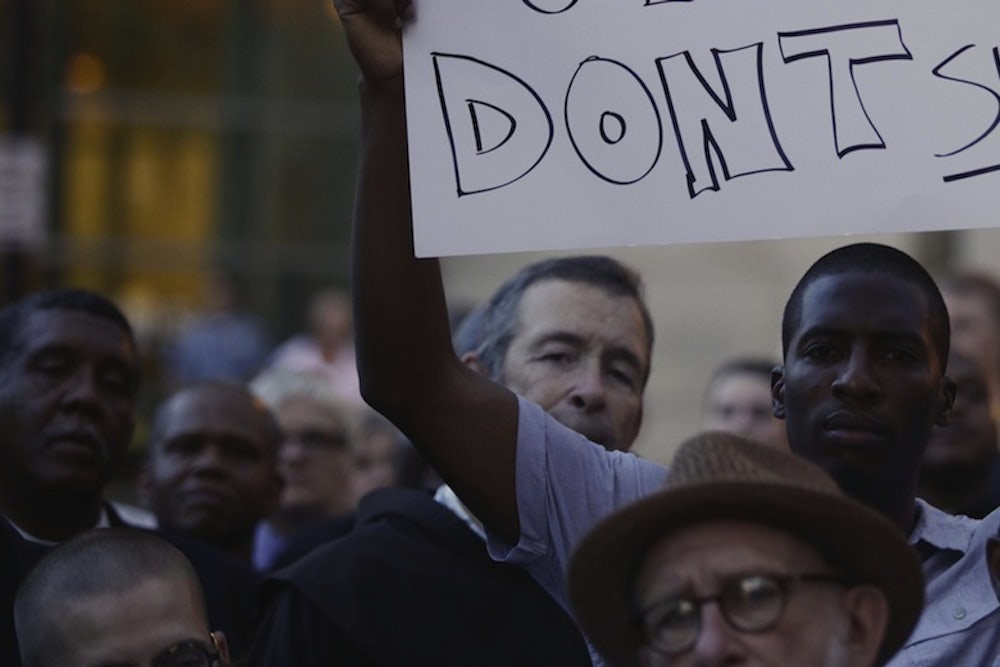The hand-held video of 25-year-old Kajieme Powell’s last moments has generated a lot of controversy, and appropriately so. You see Powell wandering around on a sidewalk in St. Louis—looking confused and mostly ignoring passersby, until a pair of police officers show up in a squad car. He approaches them, coming within a few feet before the officers fell him with a dozen rapid shots. According to the police, Powell was wielding a knife and acting in a threatening manner, and yelled at the officers to shoot and kill him as he approached.
Did the cops overreact? Some witnesses at the scene said it looked like a “suicide-by-cop.”—i.e., Powell was intentionally provoking an armed police officer to shoot him for certain death. And while Sam Dotson, the chief of the St. Louis Police, said he disagreed, Fox News pundit Geraldo Rivera quickly picked up the charge on his twitter feed, and implied it was because Powell was on drugs. “The new suicide-by-cop crowd (urban equivalent of suicide bombers) — young men who irrationally confront edgy cops who kill them — are on Dip.”
It’s an over-the-top statement, which is pretty standard behavior for Rivera. There's obviously no way to know what Powell was actually thinking before the police shot him. But there are some genuinely complicated and important questions lurking in all this talk about suicide-by-cop. What responsibilities do police officers have when they are confronting people who are threatening them, maybe even provoking a response, but seem mentally ill or intellectually disabled? Is anybody training them for situations like this?
There isn’t great information on just how often suicide-by-cop occurs, in part because not everybody agrees on the definition. In one 1998 article, published by the Federal Bureau of Investigation, criminal justice professors suggested that the suicide-by-cop accounted for 16 percent of all shootings by police, but that at least some suicidal motivation played a part in nearly half of all shootings. A more recent study, which police psychologist Kris Mohandie published in the Journal of Forensic Studies in 2009, found suicidal motivation accounted for 36 percent of more than 700 North American police shootings.
Whatever the ambiguities of the data, there’s no question that police officials are constantly dealing with people who have mental illness. In one 1999 study, psychiatrists found 7 percent of all police investigations and complaints involved a mentally ill person in one 1999 study. California’s police training commission puts the rate of calls involving someone with a likely mental illness at 15 percent.
In practice, police are frequently the first responders to mental health crises—and they are frequently unprepared to handle them. Police training typically emphasizes asserting command and authority. As the National Alliance on Mental Illness (NAMI) has pointed out that’s precisely the wrong approach to take with somebody who has mental illness, because it can disorient that person and encourage him or her to strike out.
“Traditional law enforcement tactics are rooted in logic, in reasoning – and in issuing commands for someone to comply so that we can make the situation safe right now by taking a person into custody,” said Douglas County Police Capt. Attila Denes, who's worked to improve police interaction with the mentally ill, according to an Al Jazeera report. “But barking orders at a person with serious mental illness doesn't work.”
Tellingly, Mohandie’s research suggested that 81 percent of suicide-by-cop victims do not plan for it. They decide to do it spontaneously, once police arrive and the situation escalates.
Mental health professionals have laid out guidelines for how police should deal with these situations: When officers confront somebody who is mentally ill or disabled, they should provide the person with space, if possible, and talk to them—as long as anyone in harm’s way can clear and no one is immediately threatened. But too often cops don’t take that approach and tragedy ensues, as it did not long ago in a Maryland movie theater. In October 2013, a man with Down syndrome refused to leave the theater because he wanted to watch a movie again and yelled at three off-duty officers. The officers restrained him, instead of giving him space. He died of asphyxiation. In January, a North Carolina teen died when his family called 911 to help subdue the schizophrenic 18-year-old. Police shot the teenager, who held a screwdriver.
Better training can help avoid these situations. Some communities implement crisis intervention programs, which involve giving officers 40 hours of specialized training in recognizing and responding to people with symptoms of schizophrenia, depression, and personality disorders. The consistent message is to give people space and time, and talk with them—just as the mental health professionals recommend. But to date, only 2,700 of the nation’s 25,000 police departments have a crisis intervention team in place.
According to NAMI, "Police officers report that they feel unprepared for “mental disturbance calls” and that they encounter barriers to getting people experiencing psychiatric symptoms quickly and safely transferred to mental health treatment." With training to recognize psychiatric distress officers learn to deescalate the situation and also "learn how to link people with appropriate treatment, which has a positive impact on fostering recovery and reducing recidivism.”
If the numbers don’t improve, there are bound to be a lot more shootings like the one that took place in St. Louis last week.
